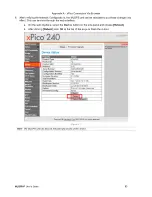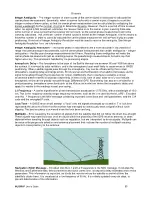
Glossary
92
MLGPS-P
User's Guide
Carrier Phase Measurement
‒ GNSS positioning is possible due to
trilateration
, a geometric method of
determining position by measuring distances to points with known coordinates. The distances used in the case
of GNSS positioning are the distances between the receiver and the satellites, and the known points are the
satellites (they are known points because their positions in space, or orbital parameters, are broadcast in the
NAV message). When a receiver can determine its distance from at least four separate satellites, it can
determine its own position on the Earth, in three dimensions.
One method to determine this distance is the
carrier phase measurement
. The carrier phase measurement is
the measure of range between a satellite and receiver, expressed in units of cycles of the carrier signal
frequency. Because the length of a complete wavelength is known for the carrier signals (19 cm for the L1
frequency), the receiver can count the integer number of completed cycles of the frequency and multiply that
number by the length of the wavelength to determine the distance. This is a much more precise range
estimation than that of pseudorange. However, there is a major source of error in this method: a receiver can
only begin counting the number of completed cycles of the frequency
after
it locks on to the signal. This means
that there is a time where the signal is being broadcast and the receiver has not locked on, meaning there is an
unknown number of completed cycles that the receiver didn't count. This is known as the
integer ambiguity
. It
must be resolved with an integer ambiguity resolution, as the carrier phase measurement will not be accurate if
the true number of completed cycles is unknown. See Integer Ambiguity and Integer Ambiguity Resolution for
more information.
The carrier phase measurement is highly precise (sub-centimeter at times) when ambiguities are resolved for,
and can be used to achieve more accurate results than the pseudorange, despite being more time consuming.
Carrier Phase Transmission
‒ See Carrier Signals.
Carrier Signals
‒ The base satellite transmissions. They include the
L1
,
L2
and
L5
frequencies that broadcast
data to receivers for positioning. Encoded onto these carrier signals is information such as the C/A and P
codes and Navigation Message.
Constellation
‒ A GNSS is a system of satellites orbiting the Earth. The orbit design of that system of satellites
is the
constellation
. Because GNSS's provide global coverage, constellations consist of at least 24 operational
satellites at any time, and are meant to allow receivers on the ground a view of at least 4 satellites at any time,
the minimum required for positioning.
Course Acquisition
(
C/A
)
Code
‒ A code containing the time when the signal was transmitted, according to
the satellite clock. It is encoded onto the L1 frequency and is transmitted at 1.023 Mbps. It is unique to each
satellite.
Cycle Slip
‒ The
carrier phase measurement
relies on an accurate count of the number of cycles of the carrier
signal frequency. The receiver can count these cycles when it locks on to the signal. However, if the receiver
temporarily loses lock, it will no longer be able to count these cycles, and the carrier phase measurement will
not be accurate. This loss of lock is known as
cycle slip
. This loss or interruption can be caused by blockage of
the signal by objects, especially when satellites are at a low Elevation. Once the cycle slip has occurred, and
the receiver has locked on to the signal again and reinitialized the integer phase cycle count, the
integer
ambiguity resolution
will need to be applied in order to repair the carrier phase measurement and resume
precise positioning. The result of a cycle slip is less precise positioning and delay in processing. See Integer
Ambiguity and Carrier Phase Measurement for more information.
Dynamic Host Configuration Protocol
(
DHCP
) ‒ A mechanism used in computer networks to assign IP
addresses automatically.







































